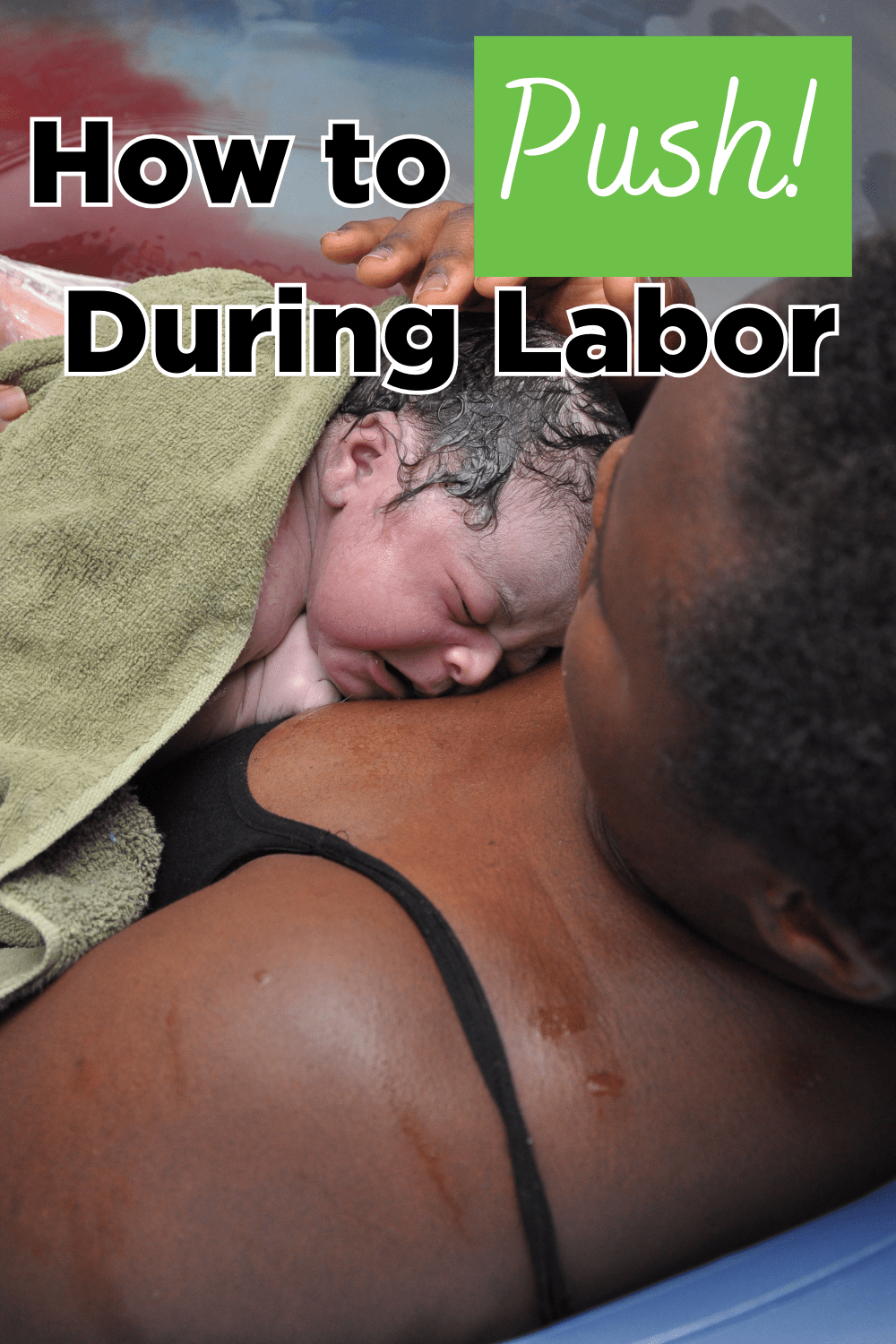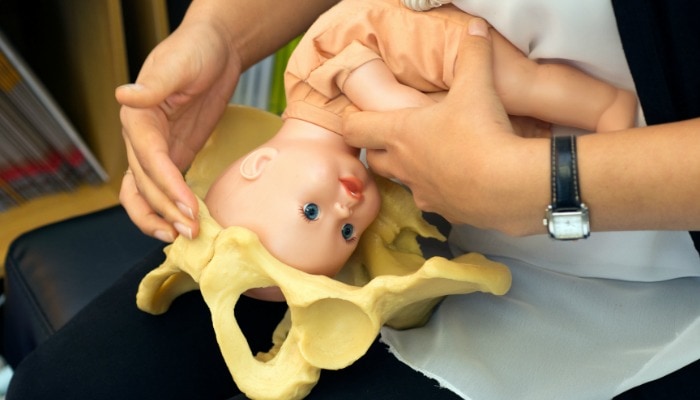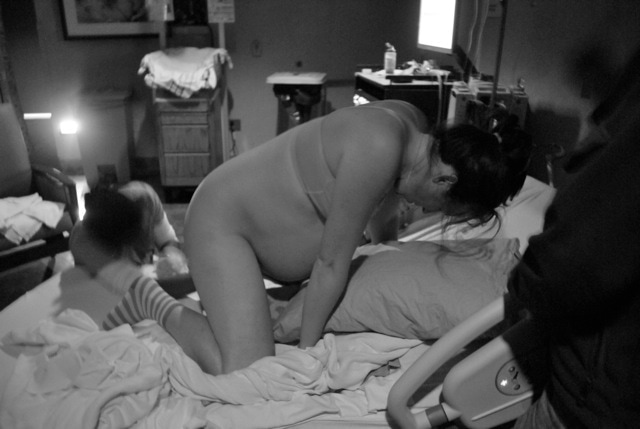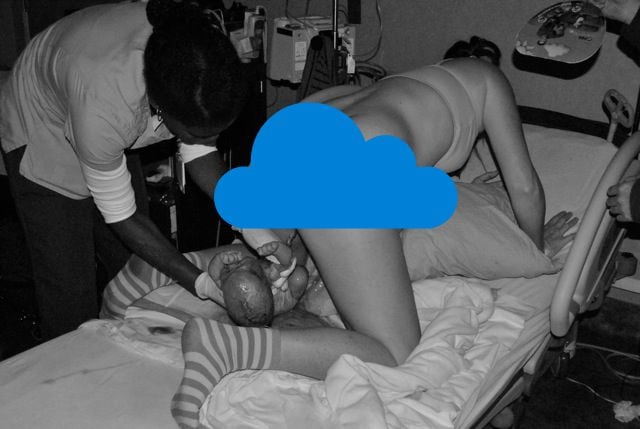Parents usually have six questions about how to push during labor and delivery.
- How do I know when to push?
- What if I don’t feel the urge to push?
- How long will it take to push out my baby?
- Can I push without pooping?
- How can I push without tearing?
- How can I push through the pain?
In this article we will answer these questions, but also talk about the ins and outs (pun intended!) of all things pushing.
On This Page
9 minute read
↓Understanding the Stages of Labor
↓How Do I Know When to Push?
↓How to Push With an Epidural
↓Laboring Down
↓What if I Don’t Feel the Urge to Push?
↓How Long Does Pushing Take?
↓How Can I Push Without Pooping?
↓How Can I Push Without Tearing?
↓How to Push Through Labor Pain

Understanding the Stages of Labor
Before we discuss how to push during labor, let’s spend a moment reviewing the three stages of labor.
Stage 1: Labor, Dilation, and Descent
Stage 2: Pushing and Birth of the Baby
Stage 3: Delivery of the Placenta
(To read more about the stages of labor and how to cope through it all, check out my post The Doula’s Guide to the Stages of Labor.)
How Do I Know When to Push?
Many parents wonder how they will know when to push. There are a few answers to this question. The easiest answer is that you push when your body “just does it”. Pushing can be compared to a sneeze or the vomiting reflex. Pushing is reflexive and believe or not, it’s called the fetal ejection reflex (lol).
Pushing is an involuntary response. It can actually be hard to NOT push when your body is pushing.
If unmedicated and feeling the urge to push, it is likely time to push. At this point women sometimes ask for a cervical exam to ensure she is fully dilated. If she isn’t 10 cm she may be asked to pant, blow, and/or change positions to push less or possibly stop pushing (which is likely impossible).

How to Push With an Epidural
On the other hand, if a woman has an epidural she will not feel that reflexive feeling/the urge to push. She will know when to push when her nurse or doc says so. However, even with an epidural many women know something has changed when they begin to feel a ton of pressure in their pelvis.
Laboring Down
Sometimes with an epidural birth care providers have parents “labor down” before officially starting the pushing stage. Basically this means they let the baby come down on its own without getting into the pushing position and bearing down.
Since it usually takes longer to push out a baby with an epidural, “laboring down” helps the body do some of the early work of the pushing phase.

What If I Don’t Feel the Urge to Push?
If you get a vaginal/cervical exam and are 10 cm but don’t feel like the urge to bear down, what’s a gal to do?
Not feeling the urge to push isn’t necessarily a problem. Right before pushing contractions sometimes space out and an opportunity for rest between contractions presents itself. Take advantage of this! This could help build energy for what’s to come. However, I do understand wondering if there’s a way to turn on the pushing reflex and get the show on the road.
Try Something New
One of the first things to try to help bring on the urge to push is to change positions. If you have been lying down, try standing up, squatting, getting into the tub, walking, hoolahooping, lunges, etc. You could also try sitting on a birthing ball. The pressure from the ball could make that urge to push happen quite quickly!

If position changes don’t trigger the urge to push… you could just do nothing. When mom and baby are fine it’s ok to just try to rest and take a break before the big finale. Not feeling the urge to push in and of itself is not a problem or emergency.
If you are over it and ready to see your baby, try bearing down a little and see how that feels. (Bear down like you’re having a bowel movement.) Sometimes women don’t feel an overwhelming urge to push and bearing down a little during contractions can help. This tiny push may spur on the urge to push and you will be well on your way to baby.
(Someone who was in one of my classes said that with her last baby she never felt the urge to push, but she decided to push anyways and her baby practically fell out. We never know!)
How Long Does Pushing Take?
How long does it take to push out a baby anyways? Let’s see… my vaginal crystal ball says 30 minutes. Oh, wait… 90 minutes. I mean 180 minutes. Honestly, nobody knows how long it will take you to push out your baby.
Ok, ok… The average first time mom takes around 1.5 hours to push her baby out. However, some women will give birth faster or slower than the average.
TIP: A mistakes new moms make during pushing is to think the third stage of labor will be quick! Hollywood certainly has taught us that birth is an emergency. 😉 Do yourself a favor and expect pushing to take awhile.
How Long With an Epidural?
If a first time mom has an epidural the range of normal is even longer. She could be pushing for 3-4 hours, or even more! ACOG supports first time moms with epidurals to push for many hours, assuming mom and baby are healthy. It could be awhile!
Two women in a recent childbirth classes took about 30 minutes to push out their first babies. So, your guess is as good as mine. 😉
TIP: To speed up the pushing process try an upright position and make sure you’re off your back!

ABOVE PHOTO: Here I am pushing my first child out. I had to push with everything I had! I was a bit surpriised at how much work it was. It took me 2.5 hours with my first.
BELOW PHOTOS: With my second and third babies, however, I pushed them out in a matter of minutes. It was shockingly different. They came so quickly!



How Can I Push Without Pooping?
Will you poop in front of everybody? Possibly. Probably. 😉 Looking at the anatomy of a pregnant woman shows us that to push a baby out, the baby’s head pushes EVERYTHING out with it.
But get this – when I see poop during the pushing phase at birth I get excited because I know she is pushing correctly and making great progress! To birth professionals, pooping during pushing a no big deal type of thing – even celebrated! Understandably so, this may give a pregnant person nightmares.
Here’s some good news! A sign of labor and symptoms of early labor both include loose stools. Sometimes everything works itself out before pushing even happens.
TIP: If you’re wanting to push without pooping, some parents use an enema in the early stages of labor (with the guidance of their care provider) to flush themselves out.
TIP: If you’re unsure of what the early stages of labor looks like, head on over here.

(Let’s Talk More About Pooping)
What would this mean to you if you pooped during pushing? What would you tell yourself about yourself? Think about that for a moment… What would your I AM statement be if you pooped when you pushed out your baby?
I AM _____________.
Now, take another moment and think about if that I am statement is serving you. No? I didn’t think so!
What would you like to tell yourself about yourself instead? If you were working really hard, pushing with all you had, bringing your baby down, and then you pooped…
I AM _____________… what?
See if you could look at this potential situation with new eyes, eyes of love and acceptance. 🙂
How Can I Push Without Tearing?
There are many techniques that can prevent tearing at birth. Unfortunately, many of these are not practiced in the average birth setting. Instead, common mistakes are made that actually don’t prevent tearing.
Here are a few helpful ideas to reduce the chance of tearing.
- Use warm compresses on the perineum when baby begins to crown.
- Do not use perineal massage during the pushing stage.
- Care providers should use a “hands poised” instead of “hands on” approach.
- Use pushing positions where pressure is off the sacrum.
- Avoid the squatting position unless squatting is part of daily life.
- Relax the mind and body throughout the pushing stage.
TIP: Here’s one of Mother Rising’s most popular articles – all about how to prevent tearing at birth.
How to Push Through Labor Pain
Many parents want to know how to push through the pain of an unmedicated childbirth. I’ve got some good news for you!
After transition, one of the most difficult parts of labor, many women report their experience becoming easier. Not only do contractions sometimes space out during the pushing phase, but women typically are able to cope through the pain of contractions better as well.
Because contractions sometimes space out a tiny bit during the pushing phase, women have more opportunity to rest, relax, and even sleep between pushing contractions. Rest helps tremendously when coping through labor unmedicated.
Also, women usually prefer pushing over transition because now they are able to “do something with their contractions” instead of just experiencing them.
Of course, women will continue to benefit from using breathing techniques throughout labor on into the pushing stage. Especially for those that are unmedicated, it’s often best to let a woman breath and push spontaneously and naturally to maximize oxygen for mom and baby. Oxygen is wonderful! 😉

Want More?
Want to learn more about birth and pushing?

Melissa Rowe
Monday 20th of May 2024
This is a very informative guide on pushing during labor! The tips and techniques provided are clear and reassuring, helping expectant mothers feel more prepared for the birthing process. Thanks for sharing this valuable resource!
Regards Melissa Rowe https://cuddlepixie.com/
Jasmine
Monday 19th of July 2021
I have read alot of post about all stages of labor and your is the first one I've seen that really tells it like it is. I tried my best to prepare myself fory daughter and nothing prepared me for labour. Your post was the first that says "your body just does it" that is really helpful for those who have never experienced childbirth.
Lindsey VanAlstyne
Tuesday 20th of July 2021
I'm so glad it was helpful!
Nathalie Duverna
Sunday 23rd of February 2020
I've had a few children and now I will be giving birth to twins. I've had both big babies and smaller babies but like I said now TWINS!!! I'm slightly afraid due to the complications of the pregnancy so the birth fears are a nightmare. Any advice???
Lindsey VanAlstyne
Monday 24th of February 2020
You got this! (How is it going between you and your care provider?)
Confused mom
Saturday 27th of July 2019
I already have 2 girls both were induced because I had cholastasis, now I am expecting twins and with cholastasis they planning to induce the labor too, but I am so scared I am having contractions babies are both head down Thanks God, (I really want a vaginal delivery) I don't know what to do since with my first two I didn't feel anything until I got the Induce medicine. I got checked my cervix yesterday and was 2 centimeter dilated, today I been feeling so bad, I haven't sleep in 3 day because of the itching caused by the cholastasis, I been vomiting almost everything I have eat today and also have heartburns, I feel so miserable and confused, I don't know what to do, I'm 35 weeks and 5 days, and my induced is scheduled until 37 weeks, I really want to make it to that point. I am so scared because I don't know if the contractions I have are because I am in labor, water hasn't broke yet. Please any advice.
Amber
Wednesday 10th of July 2019
Ugh so not true in my case! My first I definitely pooped while pushing lol. But it had nothing to do with efficiency! I ended up pushing naturally for 5.5 hours 45 minutes of which was on an ambulance. My second I pushed 3.5 hours and ended up with an emergency cs due to her position. Currently in early labor with my third. Going to try for a vbac. Both times I couldn't NOT push. I knew as soon as the urge came because it was sooo strong! Not sure why it didn't work. I saw a chiropractor this time so hoping it helps!!